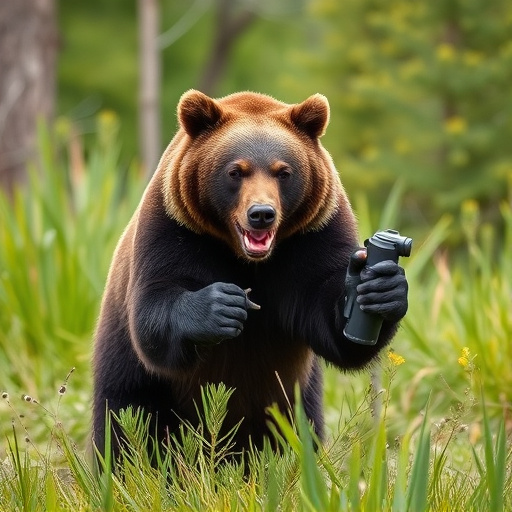The optimal distance for effective bear spray usage is 20-30 feet (6-9 meters), ensuring the spray reaches the bear's face and eyes while maintaining user safety. This range varies based on terrain, weather, and bear behavior, with open areas allowing for greater reach. In Alaska, maintain a minimum distance of 75 feet (23 meters) and aim directly at the bear's face and eyes. Practice deployment in different conditions for familiarity and use it at the first sign of a bear while staying calm.
Alaska’s rugged wilderness is home to powerful bears, making bear repellent an essential tool for outdoor enthusiasts. Understanding the maximum range of bear spray is crucial for safety in this environment. This article delves into the science behind bear spray effectiveness and explores factors influencing the optimal distance for deployment. We provide practical tips to maximize protection, ensuring you’re prepared when facing these majestic yet potent creatures. By knowing the right techniques and distances, adventurers can enhance their safety while exploring Alaska’s beautiful landscapes.
- Understanding Bear Spray Effectiveness and Safety
- Factors Affecting the Optimal Distance for Bear Spray
- Maximizing Protection: Tips for Effective Use of Bear Repellent Spray
Understanding Bear Spray Effectiveness and Safety
Factors Affecting the Optimal Distance for Bear Spray
The optimal distance for bear spray, or the maximum range it’s effective over, can vary greatly depending on several factors. One key determinant is the terrain; in open areas with minimal obstructions like trees or rocky outcrops, the spray’s reach can extend further. Conversely, dense forests or rugged landscapes may limit the effective range due to reduced visibility and the spray being blocked by obstacles.
Weather conditions also play a significant role. Wind patterns can carry bear spray away from its intended target, reducing its maximum range. Additionally, temperature and humidity levels can affect the spray’s volatility; colder temperatures tend to slow down evaporation, while warmer, drier air may cause it to dissipate more quickly. Bear behavior is another factor; a bear might move unpredictably or charge, rendering distance calculations less accurate.
Maximizing Protection: Tips for Effective Use of Bear Repellent Spray
To maximize protection, it’s crucial to understand and adhere to the optimal distance for bear spray use. When in Alaska’s wild, keep a safe distance of at least 75 feet (23 meters) from bears at all times. This is the recommended range where the spray is most effective. Bears have excellent senses, so staying within this zone ensures the repellent can be effectively applied directly to their faces and noses, creating an instant deterrent.
When using bear spray, aim high. Direct the stream towards the bear’s face and eyes, as this will reduce the chance of inhalation and ensure a more direct hit. Practice deploying the spray in various conditions before venturing into bear country to familiarize yourself with its range and effectiveness. Remember, timing is key; use it at the first sign of a bear and stay calm to increase your chances of safe passage.
In understanding the optimal distance for bear spray and its effectiveness, it’s clear that knowledge is key to keeping yourself safe in Alaska’s wild landscapes. By considering factors like wind, terrain, and bear behavior, you can maximize protection. Remember, when used properly, bear repellent spray can create a crucial buffer zone, allowing you to enjoy outdoor activities with reduced risk. Always follow safety guidelines and be mindful of the recommended maximum range for optimal results.
